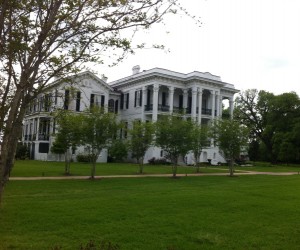 Bob and I are on a trip to Florida, Louisiana, Alabama, and Mississippi. It is a trip I have looked forward to for some time. As I have read through letters from the past and searched for past records for my family, it seems fitting that I should travel to an area of our country in which resides so much of our nation’s past. I don’t know if any of my ancestors were plantation owners or not, but I do know that some of them came from the south, so I suppose there is a possibility.
Bob and I are on a trip to Florida, Louisiana, Alabama, and Mississippi. It is a trip I have looked forward to for some time. As I have read through letters from the past and searched for past records for my family, it seems fitting that I should travel to an area of our country in which resides so much of our nation’s past. I don’t know if any of my ancestors were plantation owners or not, but I do know that some of them came from the south, so I suppose there is a possibility.
Going through Nottoway Plantation, gave us a peek into the lives of the very wealthiest plantation owners. These were people who could not “afford” to marry for love. Every child in the family knew what was expected of them. You married to better your standing and value…even if that meant marrying your cousin, as did happen in some cases, but was not totally common. Does this remind you of “Gone With The Wind”? It did us, but that is how the wealthy lived in those days, and maybe even more than we know in today’s world.
The Randolf family completed Nottoway Plantation in 1859 after 2 years of construction. It was situated right on the Mississippi River, and that was how the family traveled…by river boat, directly into New Orleans. They new no shortage of funds, and lived extravagantly…at least until the Civil War broke out in 1861. One of their sons was killed in the war, one became ill and was sent home, and one was captured. Still, the family proved what they were made of. The father, John went to Texas to grow cotton in order to make money, and the wife and some of the daughters stayed in the family home…even when the Yankee troops showed up. A wise woman, Emily offered to let the troops camp on her property and use what they needed. They took most of the vegetables and livestock, but left the home and the women alone…mostly because one of the soldiers knew one of the Randolf boys.
The home was made of the finest Virginia Cypress wood, which resisted rotting and termites, so the home has endured through the years. The shutters made of the same wood, are simply closed when hurricanes came, and the glass is even protected. The home is beautiful, and the family held many balls there as their children came of age for marrying, because they had to make sure that their children married from the right families.

While this family was wealthy and extravagant, they were also among the few families in the South who were good to their slaves. After the harvest and at Christmas time, John Randolf roasted a pig, and the family ate with the slaves. During that party, John handed out money to his slaves as a reward for jobs well done. Because of that, when the Civil War was over, and John offered contracts to his slaves, so they could now work for a wage, most of them stayed on with him. From the pay they had received through the years, they trusted him to keep his word and pay them after the war as well.
As I said, I don’t know if my family were plantation owners or not, but I like to think that if they were, they would be like John and Emily Randolf, who treated their slaves with kindness. I don’t like the idea of slavery, but I suppose that the people of that time didn’t know any different. It was a different culture, and as far as slaves are concerned, one that I think should not have happened, but unfortunately it is a part if our nation’s past.


2 Responses to A Different Culture